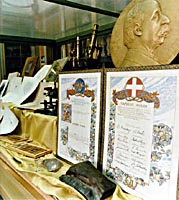|
|
Museum
The idea of a university medical history museum was born with the reforms of Maria Teresa and Joseph II. In the second half of the 18th Century, the reforming atmosphere of The Enlightenment also involved Pavia University, an until then almost forgotten outpost of the Empire. Empress Maria Teresa of Austria and her heir, Emperor Joseph II, both enlightened monarchs, took an interest in the rebirth and redevelopment of the ancient university. They brought about educational and scientific reforms as well renovating the buildings. After various attempts, the 1771 Pedagogical Plan and the 1773 Scientific Plan were accepted by the Magistrate General of Studies. These were intended to control the entry of students into faculties, the appointment of the best-known and most scientifically valuable professors, and to replace superfluous teaching by more modern, essentially experimental didactics.
To this end arose the newly organised library, anatomy theatre, Natural History Museum, Chemistry laboratory and various teaching laboratories, botanical garden, experimental Physics and anatomy laboratory. The present museum set-up, however, occupying as it does what used to be the Faculty of Medicine buildings, next to the so-called Antonio Scarpa Anatomy Theatre, only dates back to the nineteen thirties.
The Museum was actually set up in 1932, to house the exhibition material from the Palazzo Botta used to celebrate the centenary of the death of Scarpa, the founder of the Pavia Anatomy School. The exhibition was organised by Antonio Pensa, President of the IVth convention of the Italian Anatomical Society and Regius Professor of Human Anatomy. It was a most successful exhibition, with the public and with Medical and Natural Science historians. Among the exhibits on this occasion were Scarpa's own manuscripts, printed works and anatomic preparations, as well as those of other anatomists, Rezia and Panizza, preserved in the Anatomy Museum.
The Anatomy Cabinet, created and enlarged by Scarpa and his successors, was the headquarters, for about one century, of the Anatomy Institute, until said Institute was transferred to the Palazzo Botta in 1902 and the laboratory rooms became the seat of the Anatomy Pathology Institute.
After the 1932 exhibition, the Anatomy Pathology Institute moved to new premises in via Forlanini. The space left in the university buildings was used for storing material connected with anatomy, and this became the nucleus of the present museum collection.
In the same year, the nascent Museum received various scientific relics which had been returned to the University after the History of Science Exhibition in Florence. These included A. Volta's Physics Cabinet and the specimens connected with vascular and osteo-articular pathology kept in the former Porta Museum. This Museum was in the Clinical Surgery wing of the old St. Matthew's Hospital, until that also moved to the new Polyclinic premises.
The present Museum was then officially opened in 1936, since which time it has been filled out with objects from university institutes, existing museums or private donations. Among these last, we should remember those donations, from the descendants of Golgi, of his manuscripts, lecture notes and academic honours from Italian and foreign universities, his correspondence (organised by his student Veratti) and especially the original Nobel Prize certificate awarded him in 1906.
 During the war, the Museum remained closed and its contents were transferred to a safe place. Immediately after the war, thanks to the University's Chancellor Fraccaro, the Museum was enlarged by the addition of curios, rediscovered objects and documents, and donations of great value. During the war, the Museum remained closed and its contents were transferred to a safe place. Immediately after the war, thanks to the University's Chancellor Fraccaro, the Museum was enlarged by the addition of curios, rediscovered objects and documents, and donations of great value.
Subsequently, as at the time of its foundation, access was re-established to the Scarpa Lecture Theatre, through the cloistered quadrangle, and the Museum was enlarged by annexing considerable space in which to house the Physics apparatus which Volta and his successors, Configliachi, Belli and Cantoni, bought or had constructed.
In addition to the anatomic preparations, physical and surgical instruments, documents on the history of the university and curios, the Museum possesses a lot of material which, for lack of space, cannot be on public display but is shown in rotation or by special request. Many hand-written documents and papers are collected in files for ease of reference. There are manuscripts by Volta, Foscolo, Monti, Spallanzani, Moscati, Golgi, and Oehl (whose entire treatise is Museum property though only the preface is on view), Valentino Brugnatelli, Romagnosi, Adelaide Cairoli and other people of note. Of the numerous volumes containing Luigi Porta's casehistories and reports on experiments, only a few are on show; the rest are kept in cupboards which contain other historical and scientific books of particular importance.
|
|